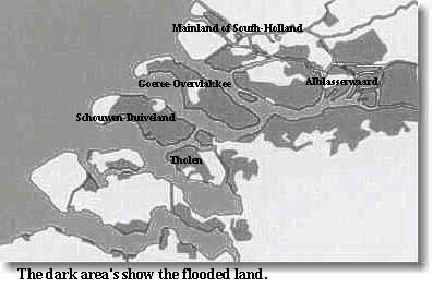The End


|
Next page
In February 1953 The Netherlands was confronted with the worst natural disaster in its history. During an extremely strong storm, the North Sea flooded the river-delta of the southern part of Holland. No less than 1835 people were killed, 47000 houses were destroyed, 48 km's of dikes were burst, 139 kilometers of dikes were damaged of which 51 km's beyond repair. Zeeland, the south part of Zuid-Holland and the west part of Noord-Brabant were severely damaged. Except for a few small parts both the islands Schouwen-Duiveland and Goeree-Overvlakkee were completely vanished. This was a national catastrophe. It took until the end of the year to repair most of the damage and to dry the land. This was the price we had to pay by living under the sea level, as approximately 60% of The Netherlands is.
The dutch government decided "this should never happen again" and started later that year the 'Deltaplan', an operation that involved building tens of kilometers of dykes, bridges and dams, all together called the 'Deltawerken'. This project should prevent our country from ever flooding again. The project has endured for 30 years and costed more than 15 billion guilders. During the Deltaplan, several new techniques in building dikes were developed. Also, new ships to make those new techniques happen were developed.
The easiest way to establish maximum safety would have been to lock up the entire country with gigantic dykes. But Holland always has made a living by sailing the seas and trading abroad and in its sea-ports. The city of Rotterdam even has one of the largest sea-ports in the world. Besides that, stopping the tides would destroy much of the natural life in the river-deltas. By doing this greater problems will be created up river. Also for economical reasons shipping and fishing must be ensured. Therefore a complex of locks, sluices, channels, bridges, slides and gates must be designed.
These reasons mean that the Deltaplan should have amongst others, some very special dams that allow the water to come in, but stop it if needed, hence the "Pijlerdam". But projects like these are difficult to realise and nobody had any experience with them. Therefore, in the fifties when the Deltaplan was started, the easier projects were performed first. During these projects new techniques were developed and experience was build up. During the years the projects got bigger and more difficult.
We will pay a visit to the pijlerdam. Also, on the way to the Pijlerdam this Friday we will pass the Philipsdam with the Krammersluizen, a real stunning view...
On the artificial island "Neeltje Jans" we will visit "Neeltje Jans Waterland". This includes:
The End


|